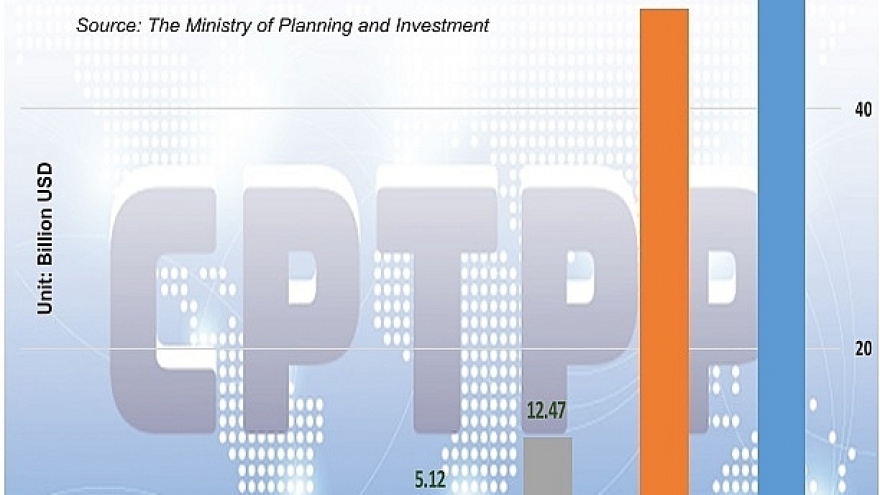CPTPP to give boost to manufacturing - processing industry
VOV.VN - A slew of major Vietnamese exports are set to benefit from golden opportunities emerging from the CPTPP trade pact which came into force in Vietnam on January 14.
 |
| Origin rules emerge as a considerable barrier for local garment and textile sector since up to 60 per cent of textile inputs and garment materials are imported from non-CPTPP member countries. |
According to the Industry Agency under the Ministry of Industry and Trade (MoIT), the Comprehensive and Progressive Agreement for Trans-Pacific Partnership (CPTPP) is hoped to leverage exports from the domestic manufacturing and processing sector, including garments and textiles, footwear, wooden items, and aquatic products.
Joining the CPTPP helps Vietnam to multilateralize its foreign economic and trading relations as well as avoiding potential risks of relying heavily on some major importing countries.
The new - generation trade pact is projected to significantly offer arrangements and orders with new importers, especially those from countries that Vietnam has yet to sign a free trade agreement with.
Notably the CPTPP membership enables Vietnam to establish free trade partnerships for the first time with three countries in the Americas, including Canada, Peru, and Mexico.
Goods imported into these countries would enjoy very favorable tariff incentives as Canada, Peru, and Mexico have all pledged to slash tariffs by 94 per cent, 81 per cent, and 77 per cent respectively once the pact takes effect. This would give big advantages to Vietnam’s manufactured and processed exports, including garments and textiles, footwear, wooden items, and aquatic products.
Canada has already committed to reducing the tariff levied on wooden items and furniture from 9.5 per cent to 0 per cent, excluding indoor wooden chairs immune from tariffs six years after the CPTPP comes into force.
This move is of great significance to Vietnamese wooden items as such category exported to Canada amount to US$166 million a year. The Southeast Asian country provides 30 per cent of all wooden items imported into Canada, making itself the largest provider of such category to the North American country.
High hopes are set for the Mexican market. Historically, Mexico has not been a major importer of Vietnamese wooden items with the country currently imposing high tariffs of between 10 and 15 per cent on its wooden imports.
However, Mexico is set to remove all tariffs on wooden products, including wood flooring, furniture, and exterior wooden items as part of a 10-year roadmap laid out by the CPTPP. This could provide a chance for Vietnamese wooden firms to deepen their footprint in the Mexican market.
Experts believe that the CPTPP will help to give impetus to the growth of Vietnam’s manufacturing and processing industry. The trade deal is poised to drive local firms to make changes to their production methods, improve their competitive edges, and bring product quality on par to match global trends.
Despite these positives, there remains questions on how best to grasp the export chances arising from the CPTPP. In order to enjoy tariff incentives from the new-generation deal, Vietnamese goods must meet strict technical requirements and origin standards set by the CPTPP member countries.
The origin of goods and their inputs is a particular challenge set by CPTPP member countries. It comes as inputs used for the production of exports are primarily imported from non-CPTPP member countries, including China and the Republic of Korea. Hence, a shift to the source of inputs in line with CPTPP requirements is an urgent need.
Local garment and textile sector is also faced with the same issue. Garments and textiles traded between CPTPP member countries are likely to enjoy tariff incentives if fibers used for such products are made within the bloc.
This could emerge as a considerable barrier for the local sector since up to 60 per cent of textile inputs and garment materials are imported from non-CPTPP member countries.
Technical requirements for packaging, labeling, and maximum residue limit become additional barriers which could hinder the access of Vietnamese exports to the CPTPP market.
Thach Phuoc Binh, a National Assembly deputy from the southern province of Tra Vinh, said the CPTPP goes beyond traditional tariff cuts as it covers a range of rigid requirements for services, intellectual property, technical barriers, labor, and the environment.
The CPTPP could offer huge opportunities for key Vietnamese exports as well as increases in the country’s overall export turnover. But, for all of the opportunities to be taken, Vietnamese firms need to make further investment in R&D production and build up brand names for their products if they want to approach demanding markets like those within the CPTPP.
Earlier, the MoIT reported in January that the CPTPP has come into force for six member countries, including Mexico, Japan, Singapore, New Zealand, Canada, and Australia from December 30, 2018 onwards.


